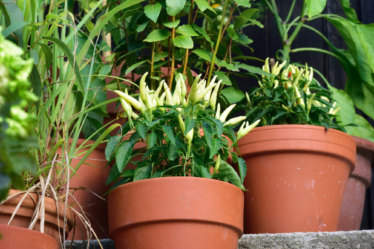
A lot of people all around the world love to add lettuce leaves to their daily salads, or in their burgers, or simply as something to munch on as a healthy snack. In many households, lettuce is a staple vegetable, something added to the menu every day.
However, lettuce is a kind of vegetable that doesn’t have a very long life. Lettuce leaves bought from the supermarket start to wilt within a few hours, especially if you are buying organic ones. Lettuce is also quite expensive if you compare them to the more affordable vegetables, and is not available in a lot of regions.
For all these reasons, deciding to grow lettuce leaves in your own home – container or vegetable garden – can be a good idea for many.
Is it Hard to Grow Lettuce at Home?
Not at all!
In fact, lettuce is one of the easiest vegetables to grow. You can easily grow more than a few lettuce plants in your very own vegetable garden or even in a container at home. This will make it easy to keep a steady stock of fresh lettuce in your home at all times without having to buy them at a high price every single time.
There are a number of varieties and options when it comes to lettuce leaves. Depending on where you live, anyone can grow at least a few types of lettuce at home. These plants can be a great addition to your already booming vegetable garden, or even the first plants you want to start your garden with.
From the garden to your salad bowl, the entire process of planting, growing, maintaining and harvesting lettuce leaves are easy and hassle-free.
Which Lettuce is Easiest to Grow?
Among all varieties, the easiest lettuce to grow is the loose-leaf variety, i.e., the variety that’s the most common in the world. These lettuce plants don’t require more than 45 to 50 days to mature and be ready for harvesting.
However, with these lettuce leaves, you won’t even have to wait so long to harvest them. As soon as some of the leaves mature, they can be cut off with a sharp knife and added to salads, sandwiches and burgers. The leaves will immediately start to regrow once they’ve been cut with a knife.
How to Grow Lettuce at Home?
- Soil
Although lettuce plants grow well in warm weather, it needs cool soil to mature. The perfect soil for lettuce plants also needs to be loose with good drainage. Regular watering isn’t necessary for lettuce and the soil these plants are growing in should be loose enough for the water to drain away after watering.
Although chemical fertilizers can be used in lettuce plants, they work better with organic fertilizers, i.e. soil enhanced with manure or compost. Adding these kinds of organic fertilizers also increase the drainage of the soil, making it more favorable for lettuce plants to thrive.
- Sunlight:
Lettuce plants can, unlike some other vegetables, live adequately both in sun and shade. However, when your lettuce plants grow the best and the fastest when they get full sunlight for at least a few hours every day.
Most varieties of lettuce plants can be considered “short-day” plants, which means that they need at least ten hours of sunlight every day. If not the sun’s direct heat, these plants at least need the sun’s light to grow their best selves.
Therefore, if you are growing lettuce leaves, they need to be planted in a part of your garden that will get the most and the longest sunlight. Even when they are being grown in a pot or a container, lettuce leaves need direct sunlight for a long time, so it will be best to put them out on a terrace or the roof.
When we say “sunlight”, it doesn’t mean that lettuce leaves need the sun’s harsh heat all day long; rather, what’s important for lettuce is to get fresh light and heat, even when it’s not very hot outside.
Some particular varieties of lettuce, like the Crisp head lettuce, don’t need too much heat or sunshine. In fact, these lettuce leaves can be harmed at extremely high temperatures.
The ideal temperature for most varieties of lettuce is somewhat between 45°F to 75°F; any more or less than that will ultimately affect the taste and the growth of the lettuce.
Apart from the sunlight, some lettuce plants also prefer partial shade, especially when the sun gets too hot around noon.
- Watering:
Unlike other vegetable plants, lettuce leaves don’t need to be watered every day. Surprisingly, these plants should only be watered twice a week. Water quantity should also be limited; even when watering lettuce leaves twice every week, not too much water should be poured on these plants.
After the initial planting, however, lettuce plants need to be watered more frequently, i.e. every other day. If you live in a dry and hot region, the seedlings might need to be watered daily. As they start growing into plants, the watering needs to be reduced to once every four to five days, or twice a week.
- Fertilizer
Lettuce plants need nutritious soil to thrive. If your region or your garden doesn’t have very high-quality soil, it can be enhanced with the right fertilizers. The proper dose of fertilizer is very important for the lettuce plants to grow right and fast.
For lettuce plants, the right fertilizer should be a balance of nitrogen, phosphate and potassium, i.e. a fertilizer with a 10-10-10 or a 5-5-5 balance.
- Harvesting:
From planting lettuce to harvesting the leaves for your meals, the entire process takes around 45 to 55 days, at best.
If you plant lettuce continuously for a few weeks in your garden, after less than two months, it will be possible to get a steady harvest as the plants will gradually start to mature. It depends on the variety that you’ve chosen to plant, but it is also possible to get a continuous supply of lettuce leaves throughout the whole season.
Some varieties of lettuce take slightly longer to mature, i.e. Iceberg lettuce might up to 90 days or 3 months to be ready for harvesting while Butterhead lettuce takes up to 80 days to mature.
However, the kind of lettuce that is most common, loose-leaf lettuce or leaf lettuce, takes less than 2 months to be ready.
Frequently Asked Questions (FAQs) About Growing Lettuce at Home
- How Do You Know When Lettuce is Ready to be Harvested?
Depending on the variety, lettuce leaves can be ready to be harvested around 30 to 80 days. You won’t have to wait till the lettuce leaves are completely formed or matured, but they can be cut off any time before that.
If you personally like your lettuce leaves young and green, you can cut them off from the stem earlier than they mature. Using a knife or a sharp blade to do so will guarantee that the leaves will regrow, giving you the same kind of green and soft lettuce leaves in a few days.
- What is the Best Time to Plant Lettuce?
Most varieties of lettuce plants grow the best when they have a lot of sunlight, which means that the best time to grow them is in spring.
Lettuce leaves need heat and sunlight to mature, but they need a relatively cooler temperature to germinate. Late spring or early fall is the perfect time for lettuce seeds to germinate into seedlings when the temperature is relatively cooler. Lettuce seeds won’t germinate when the weather gets hot outside, so it’s better not to wait till summer.
- What Should I Plant Next to Lettuce?
Companion planting, or strategically planting certain vegetables next to each other, is a great way to make sure your plants are safe.
With lettuce leaves, the best companion vegetables and herbs include:
- Dill,
- Strawberries,
- Carrots,
- Beets,
- Chervil,
- Celery,
- Cucumbers,
- Squash,
- Garlic,
- Spinach,
- Radish,
- Asparagus,
- Brassicas and
- Onions.
Some of these companion plants, beets and carrots, for example, are underground vegetables that will maximize the space under the ground since lettuce leaves don’t have very deep roots.
Chervil, on the other hand, repel lettuce-eating slugs and chives act as a barrier between lettuce plants and aphids. Garlic plants too, with their strong smell, repel slugs from eating lettuce leaves.
This way, all the vegetables and herbs in the list above help in the growth and maturity of lettuce leaves in some way as companion plants.
- Will Lettuce Regrow After Cutting?
This is another unique advantage of growing lettuce leaves: the leaves will grow back again after you’ve harvested some.
However, this will only happen if you maintain the proper procedure when cutting off the leaves from the plants. When individual lettuce plants reach full growth, its leaves need to cut off with a knife or a blade for the same leaf to grow again. If the leaves are pulled off from the plant or if the plants are completely pulled out with their roots, they won’t grow again.
Because lettuce leaves grow back, you’ll be able to harvest from the same plants again and again, but only if you cut off the leaves properly.
- How Do You Cut Lettuce So It Keeps Growing?
With lettuce, you can simply cut off the leaves, leaving the plant to keep on growing. The same leaves will regrow if they are cut out in the right way.
For lettuce leaves to regrow, they need to be cut with a knife or a sharp blade. Pulling out a lettuce leaf or pulling the plant from the soil will stop it from growing altogether. This is the reason that lettuce is mostly sold in the supermarket as individually cut leaves and never as a whole plant.
Even after cutting off a few leaves, the lettuce plant will keep on growing until its season is completely over. This means that you will be able to cut off multiple leaves from the same plants every day and the plant will still keep on growing and maturing, and the leaves will also keep on regrowing.
- What is the Most Popular Lettuce?
Loose-leaf lettuce is the most popular type all over the world because they are readily available, comparatively affordable, easy to incorporate into different recipes and most importantly, easy to grow.
Apart from loose-leaf lettuce, Crisphead, Butterhead and Romaine lettuce are also quite popular.
Lettuce leaves are one of the easiest salad greens to grow at home, both in a garden and in a pot. The right weather conditions and soil are necessary for lettuce leaves to thrive because they don’t require a lot of taking care of. With a minimum of effort, you can have freshly grown lettuce leaves for your salads and recipes every day for a long time, even from a single plant for the whole season.


